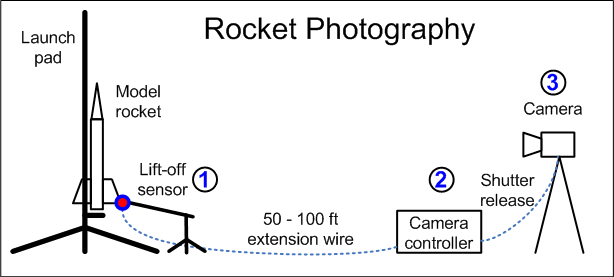and how to take it
In my view, the best composition that captures all the elements of a rocket lift-off – launch pad, thrust, smoke, and (of course) rocket – occurs after the rocket has traveled up about 2–3 feet above the launch pad. Taking such a photo calls for a precise synchronization of the camera with the rocket launch. For an average HPR launch, your camera needs to “click” about 200 ms (±50 ms) after the rocket starts to move. Too late, and the rocket will have already left the launch rail. Too early, and there is too little smoke and flame to convey the action.
Synchronization is carried out by the following three components:
- Sensor of rocket lift-off (i.e. the moment the rocket begins its upwards movement)
- Controller that monitors sensor readings, times events, and triggers the camera
- Camera
Event timeline
Below is the sequence of events that takes place right after LCO pushes the launch button:
| Time | Event |
|---|---|
| T+0 | Rocket lift-off |
| T+0 | Lift-off triggers the sensor |
| T+1ms | Controller detects the sensor state change |
| T+1ms | Controller waits for a given delay |
| T+140ms | Controller triggers the camera |
| T+140ms | Camera initiates image capture |
| T+200ms | Camera opens shutter |
| T+200ms | Camera closes shutter |
(Note: in this sequence, T denotes time of rocket lift-off rather than motor ignition).
